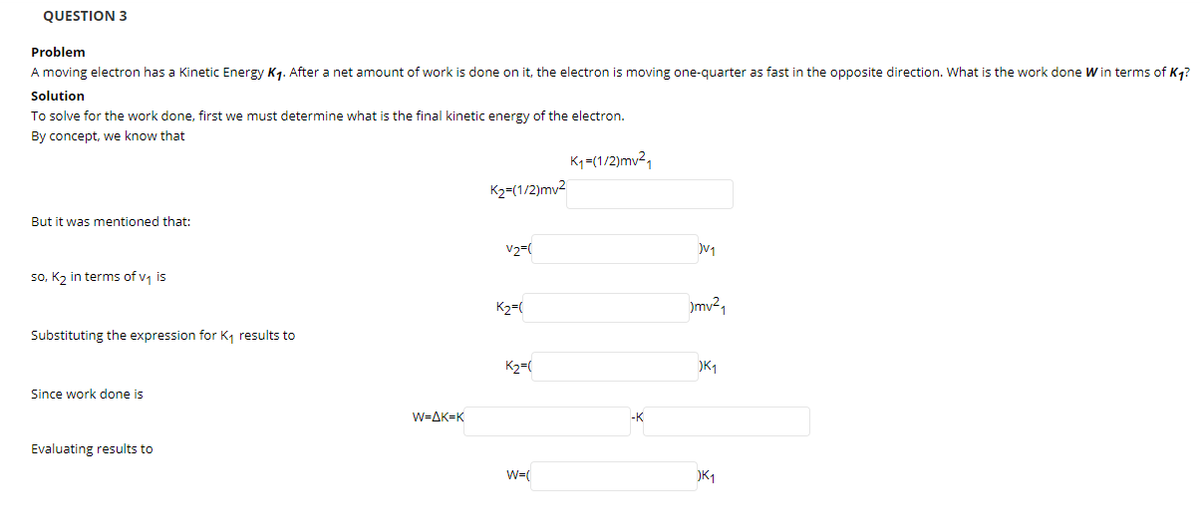Problem A moving electron has a Kinetic Energy Kg. After a net amount of work is done on it, the electron is moving one-quarter as fast in the opposite direction. What is the work done W in terms of K4? Solution To solve for the work done, first we must determine what is the final kinetic energy of the electron. By concept, we know that K1=(1/2)mv², K2=(1/2)mv2 But it was mentioned that: v2=( so, Kz in terms of v, is K2=( )mv², Substituting the expression for K1 results to
Problem A moving electron has a Kinetic Energy Kg. After a net amount of work is done on it, the electron is moving one-quarter as fast in the opposite direction. What is the work done W in terms of K4? Solution To solve for the work done, first we must determine what is the final kinetic energy of the electron. By concept, we know that K1=(1/2)mv², K2=(1/2)mv2 But it was mentioned that: v2=( so, Kz in terms of v, is K2=( )mv², Substituting the expression for K1 results to
Principles of Physics: A Calculus-Based Text
5th Edition
ISBN:9781133104261
Author:Raymond A. Serway, John W. Jewett
Publisher:Raymond A. Serway, John W. Jewett
Chapter6: Energy Of A System
Section: Chapter Questions
Problem 44P
Related questions
Question
Please help me fill in the blanks

Transcribed Image Text:QUESTION 3
Problem
A moving electron has a Kinetic Energy K1. After a net amount of work is done on it, the electron is moving one-quarter as fast in the opposite direction. What is the work done W in terms of K4?
Solution
To solve for the work done, first we must determine what is the final kinetic energy of the electron.
By concept, we know that
K-(1/2)mv21
K2=(1/2)mv2
But it was mentioned that:
V2=(
so, K, in terms of v, is
K2=(
)mv2,
Substituting the expression for K, results to
K2=(
K1
Since work done is
W=AK=K
-K
Evaluating results to
W=(
)K1
Expert Solution
This question has been solved!
Explore an expertly crafted, step-by-step solution for a thorough understanding of key concepts.
Step by step
Solved in 2 steps with 2 images

Knowledge Booster
Learn more about
Need a deep-dive on the concept behind this application? Look no further. Learn more about this topic, physics and related others by exploring similar questions and additional content below.Recommended textbooks for you

Principles of Physics: A Calculus-Based Text
Physics
ISBN:
9781133104261
Author:
Raymond A. Serway, John W. Jewett
Publisher:
Cengage Learning

Physics for Scientists and Engineers with Modern …
Physics
ISBN:
9781337553292
Author:
Raymond A. Serway, John W. Jewett
Publisher:
Cengage Learning

Physics for Scientists and Engineers
Physics
ISBN:
9781337553278
Author:
Raymond A. Serway, John W. Jewett
Publisher:
Cengage Learning

Principles of Physics: A Calculus-Based Text
Physics
ISBN:
9781133104261
Author:
Raymond A. Serway, John W. Jewett
Publisher:
Cengage Learning

Physics for Scientists and Engineers with Modern …
Physics
ISBN:
9781337553292
Author:
Raymond A. Serway, John W. Jewett
Publisher:
Cengage Learning

Physics for Scientists and Engineers
Physics
ISBN:
9781337553278
Author:
Raymond A. Serway, John W. Jewett
Publisher:
Cengage Learning

Physics for Scientists and Engineers, Technology …
Physics
ISBN:
9781305116399
Author:
Raymond A. Serway, John W. Jewett
Publisher:
Cengage Learning

College Physics
Physics
ISBN:
9781938168000
Author:
Paul Peter Urone, Roger Hinrichs
Publisher:
OpenStax College

Glencoe Physics: Principles and Problems, Student…
Physics
ISBN:
9780078807213
Author:
Paul W. Zitzewitz
Publisher:
Glencoe/McGraw-Hill